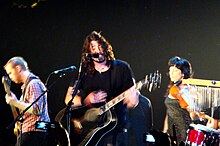Post-grunge
| Post-grunge | |
|---|---|
| Stylistic origins | Alternative rock,[1] grunge, hard rock |
| Cultural origins | Mid-1990s United States, United Kingdom, Canada and Australia |
| Typical instruments | Electric guitar • acoustic guitar • bass guitar • drums • vocal |
| Regional scenes | |
| British Columbia, California, Pacific Northwest, Southern Ontario, Upper Midwest | |
| Other topics | |
| Post-grunge bands | |
Post-grunge is a subgenre of alternative rock that emerged in the mid-1990s as a derivative of grunge, using the sounds and aesthetic of grunge, but with a more commercially acceptable tone. This made post-grunge bands like Foo Fighters, Nickelback, Creed and Matchbox Twenty among the most commercially successful rock acts of the late 1990s and early 2000s.
Characteristics
Post-grunge bands emulated the attitudes and music of grunge, particularly its thick, distorted guitars, but with a more radio-friendly commercially-oriented sound.[1] Unlike early grunge bands they often worked through the major labels and came to incorporate diverse influences from jangle pop, pop punk, ska revival, alternative metal, or hard rock.[1] The term post-grunge was meant to be pejorative, suggesting that they were simply musically derivative, or a cynical response to an "authentic" rock movement.[2]
History

Even at the height of their popularity, after the release of Nevermind (1991) brought grunge to international attention, Nirvana experienced increasing problems, partly caused by Kurt Cobain's drug addiction and growing dissatisfaction with commercial success.[3] In early 1994 Cobain was photographed in a t-shirt with 'Grunge is Dead' printed on the front and the genre's decline started to be widely discussed.[4][5] The death of Cobain in April 1994, as well as touring problems for Pearl Jam, marked a decline for grunge that year.[1] Problems of addiction for Layne Staley of Alice in Chains led to the cancellation of scheduled dates for the band in 1995.[6] As these pioneering grunge bands faltered, major record labels began signing and promoting bands that were emulating the genre.[7] The term post-grunge was coined to describe these bands.[1]
In 1995, former Nirvana drummer Dave Grohl's new band, the Foo Fighters, helped popularize the genre and define its parameters, becoming one of the most commercially successful rock bands in the US, aided by considerable airplay on MTV.[8] Some post-grunge bands, like Candlebox, were from Seattle, but the sub-genre was marked by a broadening of the geographical base of grunge, with bands like Atlanta, Georgia's Collective Soul, Australia's Silverchair and England's Bush, who all cemented post-grunge as one of the most commercially viable sub-genres by the late 1990s.[1][9] Although male bands predominated, female solo artist Alanis Morissette's 1995 album Jagged Little Pill, labelled as post-grunge, also became a multi-platinum hit.[10]
With the first wave of post-grunge bands losing popularity, bands like Puddle of Mudd, and Nickelback took post-grunge into the 21st century with considerable commercial success, abandoning most of the angst and anger of the original movement for more conventional anthems, narratives and romantic songs, and were followed in this vein by new acts including Shinedown, Seether, David Cook and Daughtry.[2][11] By the mid 2000s, the term neo-90s rock, or neo-grunge began to be used to at times in place of post grunge.[12]
Significance
With its more commercially friendly sound post-grunge bands were among the biggest selling rock artists of the later 1990s and early 2000s in the US,[1] gaining considerable airplay and able to compete with alternative metal and rap-rock bands.[2] Partly because of their more mainstream sound and greater commercial success post-grunge bands were criticised by fans and in the music press for their artistic limitations and lack of authenticity in comparison with original grunge bands.[2]
See also
Notes
- ^ a b c d e f g "Post-grunge", Allmusic, archived from the original on 13 February 2011.
- ^ a b c d T. Grierson, "Post-Grunge: A History of Post-Grunge Rock", About.com, retrieved 1 January 2010.
- ^ Prato, Greg (2009). "Everything is not OK anymore". [http://books.google.it/books?id=eTg4whS9ClUC&hl=en Grunge Is Dead: The Oral History of Seattle Rock Music]. ECW Press. p. 478. ISBN 978-15-50228-77-9. Retrieved 4 March 2012.
{{cite book}}: External link in|title= - ^ Strong, Catherine (2011). "Grunge is Dead (p. 20)". [http://books.google.it/books?id=qUhokID7qXIC&hl=en Grunge: Music and Memory]. Ashgate. p. 179. ISBN 978-14-09423-76-8. Retrieved 4 March 2012.
{{cite book}}: External link in|title= - ^ "'Grunge Is Dead' - An Interview with Greg Prato". UGO Entertainment. 2009-04-29. Retrieved 5 March 2012.
{{cite web}}: Italic or bold markup not allowed in:|publisher=(help) - ^ Rothman, Robin (2002-04-22). "Layne Staley Found Dead". Rolling Stone. Retrieved 4 March 2012.
{{cite web}}: Italic or bold markup not allowed in:|publisher=(help) - ^ M. Azerrad, Our Band Could Be Your Life: Scenes from the American Indie Underground, 1981-1991, (Boston: Little Brown and Company, 2001), ISBN 0-316-78753-1, pp. 452–3.
- ^ V. Bogdanov, C. Woodstra and S. T. Erlewine, All Music Guide to Rock: the Definitive Guide to Rock, Pop, and Soul (Backbeat Books, 3rd edn., 2002), p. 423.
- ^ V. Bogdanov, C. Woodstra and S. T. Erlewine, All Music Guide to Rock: the Definitive Guide to Rock, Pop, and Soul (Backbeat Books, 3rd edn., 2002), pp. 1344-7.
- ^ V. Bogdanov, C. Woodstra and S. T. Erlewine, All Music Guide to Rock: the Definitive Guide to Rock, Pop, and Soul (Backbeat Books, 3rd edn., 2002), p. 761.
- ^ Farber, Jim (2008-11-16). "Nickleback and David Cook releases mark the death of grunge". New York Daily News. Retrieved 2011-12-01.
- ^ Sanneh, Kelefa (2006-01-26). "Critic's Notebook; In the Wake of Grunge, A Rock Culture Clash". New York Times. Retrieved 2011-11-04.
